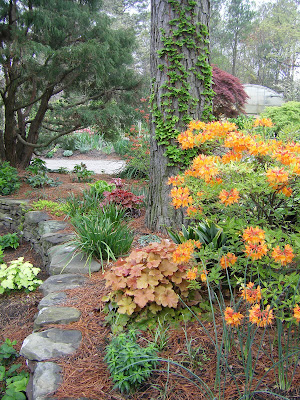Since I work every Saturday and Sunday during the spring, my son and I do not get to spend any days together for a couple of months, so I had no problem pulling him from school for a day of bonding. Our activity of choice is to spend the day at
Busch Gardens in Williamsburg, and thanks to my parents we each have a season pass. We thought that going on a pre-season Friday would let us have the park to ourselves, but it was full of high school and middle school field trippers (as if I didn't feel old enough already).

Busch Gardens has won "The Most Beautiful" park award by the members National Amusement Park Historical Association for 18 consecutive years. It is easy to see why, from its setting in the woods, to its lush landscaping. This year they offered two weekends of programs geared toward the gardening public under the title of
"Ready, Set, Grow". There were tours of some of the garden areas, the greenhouses, demonstrations and classes. I noticed too that there was a new emphasis on plant labeling that also included the Latin names.

They use a wide variety of plant material throughout the park. I particularly like the fact that they plant the perimeters of the public areas with unusual trees and shrubs. They also plant the more public beds with items most people would not consider because of the plant's ultimate size, but I know they have the resources to move things around when they out grow the space. The staff is particularly adept at containers, and they are used widely throughout the park. Their annual beds are extensively planted in a Victorian or traditional European style, and while the colors and the tidiness are not to my liking, I can appreciate the effort. I wonder if little
gartenelfin come out at night to get it all looking good for the next day.





I am going to send this to my
Monrovia sales rep. it's good product placement.

There were several other species in the park Friday besides those that fall into the flora category.



Here are a couple of cuckoos.

Finally, here are some shots of why we really go to the park. It is a great place to experience a variety of G forces (or lack thereof), speed, and simulated near death experiences.



 Busch Gardens has won "The Most Beautiful" park award by the members National Amusement Park Historical Association for 18 consecutive years. It is easy to see why, from its setting in the woods, to its lush landscaping. This year they offered two weekends of programs geared toward the gardening public under the title of "Ready, Set, Grow". There were tours of some of the garden areas, the greenhouses, demonstrations and classes. I noticed too that there was a new emphasis on plant labeling that also included the Latin names.
Busch Gardens has won "The Most Beautiful" park award by the members National Amusement Park Historical Association for 18 consecutive years. It is easy to see why, from its setting in the woods, to its lush landscaping. This year they offered two weekends of programs geared toward the gardening public under the title of "Ready, Set, Grow". There were tours of some of the garden areas, the greenhouses, demonstrations and classes. I noticed too that there was a new emphasis on plant labeling that also included the Latin names. They use a wide variety of plant material throughout the park. I particularly like the fact that they plant the perimeters of the public areas with unusual trees and shrubs. They also plant the more public beds with items most people would not consider because of the plant's ultimate size, but I know they have the resources to move things around when they out grow the space. The staff is particularly adept at containers, and they are used widely throughout the park. Their annual beds are extensively planted in a Victorian or traditional European style, and while the colors and the tidiness are not to my liking, I can appreciate the effort. I wonder if little gartenelfin come out at night to get it all looking good for the next day.
They use a wide variety of plant material throughout the park. I particularly like the fact that they plant the perimeters of the public areas with unusual trees and shrubs. They also plant the more public beds with items most people would not consider because of the plant's ultimate size, but I know they have the resources to move things around when they out grow the space. The staff is particularly adept at containers, and they are used widely throughout the park. Their annual beds are extensively planted in a Victorian or traditional European style, and while the colors and the tidiness are not to my liking, I can appreciate the effort. I wonder if little gartenelfin come out at night to get it all looking good for the next day.



 I am going to send this to my Monrovia sales rep. it's good product placement.
I am going to send this to my Monrovia sales rep. it's good product placement. There were several other species in the park Friday besides those that fall into the flora category.
There were several other species in the park Friday besides those that fall into the flora category.

 Here are a couple of cuckoos.
Here are a couple of cuckoos. Finally, here are some shots of why we really go to the park. It is a great place to experience a variety of G forces (or lack thereof), speed, and simulated near death experiences.
Finally, here are some shots of why we really go to the park. It is a great place to experience a variety of G forces (or lack thereof), speed, and simulated near death experiences.















































